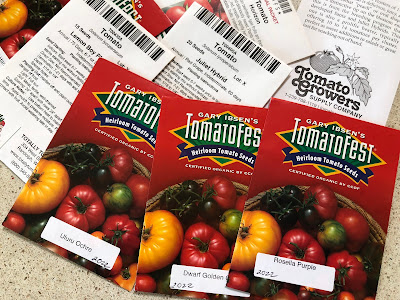
Stay warm inside and plant seeds

|
|
Dwarf varieties are among my tomato seed
purchases this year. (Photo: Kathy Morrison)
|
When it's so cold outdoors this week, it's nice to think of warmer days and summer vegetables.
There's still plenty of time to start seeds for tomatoes and other summer favorites. For a little extra help, check out an online Zoom class this weekend, presented by the Solano County master gardeners.
"Starting Seedlings for Summer, Even When It's Cold Outside" will be hosted by master gardener Alex Russell, 10 a.m. to 11 a.m. Saturday, Feb. 26. The Zoom link is here .
Last year I started all my tomatoes in late January and early February. Three weeks later, several had collapsed from inattention (I had a busy winter!) and I had to start them again -- what a waste of seeds and time. With a trip planned in the middle of the month this year, I decided to delay my seed-starting until after I returned.
The tomatoes include my favorites, Juliet, Big Beef and Lemon Boy, while this year's experiments include some of the new dwarf heirloom tomato varieties developed by the Dwarf Tomato Project and sold on the TomatoFest online store. The link will take you to a detailed description of the project, which started in 2005. For the seed listings, go here.
The distinction between dwarf tomatoes and compact determinate ones is important: The flavor apparently is better, and "these dwarf types are very distinctive in having a thick central stem, stout compact growth, and dark green, crinkly looking (so-called rugose) foliage." They top out at 3 to 4 feet in height, apparently.
This project has produced 30 varieties of open-source seeds. Many gardeners have limited space for tomatoes, so I'll be interested to see how these grow out in a Sacramento summer. I bought seeds for 4 varieties:
-- Uluru Ochre, 65 days, a 6- to 12-ounce "uniquely colored" orange-black tomato (SF Giants colors!). Indeterminate.
-- Dwarf Hannah's Prize, 75 days, 6- to 12-ounce, red with some light striping.
-- Dwarf Golden Gypsy, 75 days, 8- to 18-ounce, yellow-gold. Indeterminate.
-- Rosella Purple-Dwarf, 78 days, 6- to 12-ounce purple-black (similar to Cherokee Purple). Indeterminate.
Stay tuned this year for progress reports on these varieties.
Comments
0 comments have been posted.Sacramento Digs Gardening to your inbox.
Food in My Back Yard Series
April 1: Don't be fooled by these garden myths
March 25: Fertilizer tips: How to 'feed' your vegetables for healthy growth
March 18: Time to give vegetable seedlings some more space
March 11: Ways to win the fight against weeds
March 4: Potatoes from the garden
Feb. 25: Plant a fruit tree now -- for later
Feb. 18: How to squeeze more food into less space
Feb. 11: When to plant? Consider staggering your transplants
Feb. 4: Starting in seed starting
Sites We Like
Garden Checklist for week of March 30
Your garden doesn’t mind April showers. Get busy now to enjoy those future flowers.
* Get ready to swing into action in the vegetable garden. As nights warm up over 50 degrees, start setting out tomato, pepper and eggplant transplants.
* From seed, plant beans, beets, cantaloupes, carrots, corn, cucumbers, melons, pumpkins, radishes and squash. (Soak beet seeds overnight in water for better germination,)
* Plant onion sets.
* In the flower garden, plant seeds for asters, cosmos, celosia, marigolds, salvia, sunflowers and zinnias.
* Transplant petunias, zinnias, geraniums and other summer bloomers.
* Plant perennials and dahlia tubers for summer bloom.
* Transplant lettuce and cabbage seedlings.
* April is the last chance to plant citrus trees such as dwarf orange, lemon and kumquat. These trees also look good in landscaping and provide fresh fruit in winter.
* Smell orange blossoms? Feed citrus trees with a low dose of balanced fertilizer (such as 10-10-10) during bloom to help set fruit. Keep an eye out for ants.
* Apply slow-release fertilizer to the lawn.